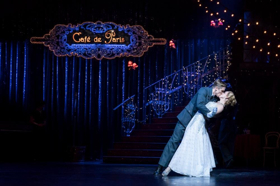Review: CINDERELLA Enchants at the Kennedy Center

After more than a decade in Washington I thought I was immune to the charm, allure, and optimism of fairy tales. That was until last night and Matthew Bourne's enchanting and cinematically stylish ballet Cinderella at the Kennedy Center. Even with a tale as old as time, yes I know that's another fairy tale, he has made this classic his own.
The challenge of presenting a new production of Cinderella on stage, be it the musical, ballet, or opera version, is how to take a story so well-known, so universal, and to give it a fresh perspective. Bourne's solution was simple, change the time and place to the Second World War. Suddenly the idea of finding love and a happy ending, amidst one of the twentieth century's greatest struggles not only seems a romantic notion, but the very idea of a perfect fairy tale.
Bourne's ballet has all the story's classic elements, with a few twists. In addition to the production's setting, London during the blitz, Prince Charming has been replaced by a pilot (Andrew Monaghan), the ball by a ritzy party at the Cafe de Paris (more on that later), and her fairy godmother is now a mysterious angel (Liam Mower). Still though, our heroine must be home by midnight, the evil stepmother, Sybil (Madelaine Brennan) continues to draw our ire and loathing, and everything comes down to a certain slipper.
Now the World War II setting is more than just a gimmick. To get the audience in the right mindset, Bourne has British newsreels shown to start the first and third acts. The setting of the party, the Cafe de Paris, was a real night club which was bombed during the War, and that event plays a significant role in how our Cinderella gets separated from her pilot. Additionally, setting the ballet in 1940 also validates the rationale of changing the fairy godmother to more of a guardian angel-type. Who better to look after you than an angel?
Enhancing this effort is Sergei Prokofiev's atmospheric score. He wrote it during the Second World War, and the influences can clearly be heard. The score is energetic and bold, but also contains recurring, foreboding melodies reminding us that during wartime, danger is never far away.
Bourne's choreography tends to lean more towards modern dance than classical ballet. If The Nutcracker is your sole entrée into the world of ballet, you may be pleasantly surprised. Forties dance crazes tend to influence the ballet's more classical style.
Shaw is dazzling as the titular character. Her Cinderella can be described as passionate - passionate to break away from serving a wicked stepmother and passionate to seize upon her moment. She is radiant in Act Two, and whether dancing in a formal gown or a drab skirt, you cannot take your eyes off her.
As far as angels go, Mower is someone who you want watching over you. There is a tenderness and poignancy to his performance that cannot go unnoticed. It as if he is balancing Cinderella's desires with the greater notion that war is leaving happy endings in short supply. And yet, we never once doubt his devotion to her, nor his ability to alter events in her favor.
Monaghan is Harry the Pilot, Cinderella's love interest. He may not have a wicked stepmother, but he does come with his own set of unique challenges. Nevertheless, Monaghan has the persistence you'd expect from a fighter pilot. It reaffirms that even with all his flaws, he will not stop searching for the matching slipper that once adorned his dream girl.
While we get that Cinderella's family is not the nicest, they tend to be more self-absorbed rather than wicked. That attribute is best reserved for Brennan's Sybil, the stepmother. With a great stage presence, she is wildly mischievous, always scheming to advance herself. A nice little element added by Bourne is that she is also a lush and philanderer, so we get the sense that her hatred of Cinderella extends to anyone she cannot control.
Lez Brotherston's costume designs cleverly uses color to accentuate the depth of differences separating step-mother and step-daughter by clothing Brennan in black velvet and black fur, while Shaw transforms into a vision of white silken elegance for the Act Two party scene. He pulls double duty serving as both costume and set designer, excelling at both. Like with his costume, he uses color to accent the Cinderella of her step-mother's household with the one that becomes the belle of the ball...err...party. Act One's household is resplendent in blacks, greys and whites, while Act II's Café de Paris explodes, literally, with color and life.
One aspect that must be appreciated is Brotherston's attention to detail. Barrage balloons fill the sky during the air raid scenes and when Mower's Angel takes Cinderella to the Café de Paris nightclub, gone is a horse drawn carriage, enter a white World War II messenger bike. These are small details but combined with Duncan McLean's projections, Paul Groothius sound design, and Neil Austin lighting design, they make the evening a completely immersive and captivating experience.
In an era where everything seemingly gets remade, and usually not for the better, the idea of seeing a Cinderella set during wartime may give you pause - don't let it! Imaginative and enchanting, stylish and cinematic, this Cinderella will leaving you feel like you just got the glass slipper. And what better feeling!
Runtime is two hours and 40 minutes with two 15 minute intermissions.
Cinderella runs thru January 20 at The John F. Kennedy Center for the Performing Arts - 2700 F St NW, Washington, DC 20566. For tickets please click here.
Photo: Andrew Monaghan 'Harry' and Ashley Shaw 'Cinderella'. Photo by Johan Persson.
Reader Reviews

Videos
